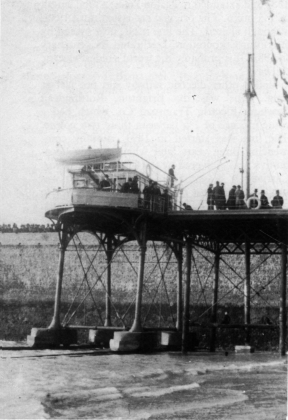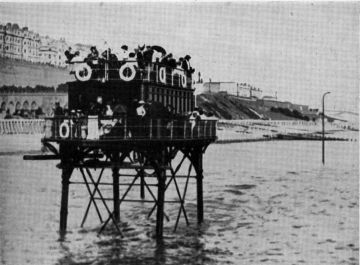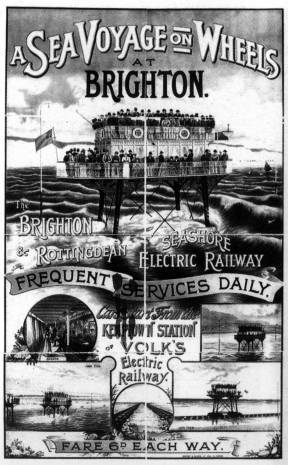
'Pioneer' at Paston Place Groyne Terminus
Seen at low tide. Note wheels and track.
THE BRIGHTON & ROTTINGDEAN SEASHORE ELECTRIC TRAMROAD COMPANY
Volk's Electric Railway remains the lasting monument to his genius, but Magnus Volk built another electric railway, more ambitious, though shorter lived than the one that still bears his name. For sheer originality it surpasses any other electric railway that has ever been constructed. Unfortunately, almost all traces of it have long since disappeared. The railway was started in 1893 and completed in 1896 as an extension of Volk's Electric Railway, running from the very substantial masonry-built Paston Place Groyne on Brighton seafront, to a jetty at the foot of the high chalk cliffs at the village of Rottingdean 4.43 km (2.75 miles) to the east. It was a tourist railway from the start, unlike Volk's Electric Railway, which also performs an urban transport function, since the normal traffic flows between Brighton and Rottingdean were small.
Its name, the Brighton and Rottingdean Seashore Electric
Tramroad, only hints at its extraordinary nature, for this was
the railway that went to sea !
The track was laid on the sea bed, some 30 metres out from dry
land, and only at low tide could it be seen (or maintained). At
high tide, it was covered by some 5 metres of sea water.

'Pioneer' at Paston
Place Groyne Terminus
Seen at low tide. Note wheels and track.
The track consisted of two parallel railway lines, mounted on very heavy concrete blocks, each line being laid to a gauge of 0.8255m (32.5 inches). The two parallel railway lines were spaced so that the two outer rails were 5.486m (18 feet or 216 inches) apart.
Only one car was provided for the railway (the term 'tramway' was a misnomer) and this was built by the Gloucester Railway Carriage and Wagon Company in 1896. At 12.27m 483 inches high without top awning and 14.05m (553 inches) with top awning, 7.62m (300 inches) wide and 15.24m (600 inches) long it was about ¾ of the length of a current 'Eurotunnel' Channel Tunnel freight shuttle wagon but nearly twice as wide and over twice as high. So a convincing case can be made for it being the largest single rail vehicle ever built. Though it carried the name 'Pioneer' (never was a name more deserved) it was affectionately known by everyone who lived in the area as 'Daddy Long Legs', the folk-name originally given to the long-legged Crane Fly.
The construction of this rail car was unique. It consisted of a deck, 15.24m long and 7.62m wide. Both ends of this deck were tapered to a blunt vee, to provide some resemblance to a ship's bow. Much of the deck space was occupied by a luxurious saloon or cabin, the roof of which formed another open deck. There was comfortable seating provided in the saloon near the large windows, and down the centre line of the saloon, a narrow jardiniere filled with semi-tropical plants ran for much of its length.
The whole superstructure was carried on four tubular steel legs, 7.32m (288 inches) high, each one terminated in a large steel foot, having four flanged railway wheels, 762 mm (20 inches) in diameter, in 2 groups of 2 with an 0.826m gauge between them. These 16 driving wheels were driven by flexible drives which passed down the middle of the tubular legs, and these drives were powered by a 25 horsepower DC motor or motors located on the main deck. Accounts differ as to whether there was one or two drive motors. My guess, as an engineer, is that there were two, one driving the wheels on the two front feet, the other the wheels on the two rear feet.
Horizontal steel tubes connected all four feet together, and apart from strengthening the structure, they may have contained drive shafts. All four legs were strongly cross-braced.
The traction current was supplied by a copper trolley wire, suspended by tubular tramway poles planted in the sea bed. Two tram-type trolley poles in tandem were mounted on the shore side of the car, both being pivoted at saloon roof level.
Fully loaded, 'Pioneer' carried 150-160 passengers in the saloon and on its two open decks. In keeping with most sea-going craft pre-RMS Titanic, it was woefully under-provided with life saving equipment, carrying only a small lifeboat slung on davits above the saloon end windows, and 4 lifebelts mainly intended to rescue passengers who fell overboard. It must have been the only train ever to have a lifeboat and lifebelts as part of its standard equipment.
A flag-staff at the other end of the car flew the 'Red Duster' the Merchant-Marine ensign. This was somewhat presumptuous, as 'Pioneer' was a vehicle that ran on wheels, and was not a ship, however much it looked like a cross between one and a seaside pier !

'Pioneer' wades through the
sea on her way to Rottingdean
Fully loaded, and wading, at high tide, through 5 metres of often very rough water, 'Pioneer' could still manage a speed of 9.7 km/h (6 mph). As all the submerged parts of the car were symmetrical, the speed of the car was the same whichever the direction of travel.
The on-shore power supply arrangements are not known, but they probably comprised a gas engine, coupled to a dynamo. No information on the traction supply voltage has yet come to hand, but because of the tramway boom of the 1890's, it is very likely that 'Pioneer's' motors were standard tramway ones operating at some 500v DC.
One photograph, not reproduced here, was issued as a postcard, No M591 by Pamlin Prints, Croydon, UK (wrongly titled and dated). Taken around 1900, it shows a downward sloping canvas awning at the non-lifeboat end of the saloon, to provide reasonable rain protection to people standing at that end of the main open deck. It also shows a large, almost flat canvas roof erected on hgh poles over the entire saloon roof open deck. This high, shallow roof, because it had no side awnings, would have been virtually useless for rain and wind protection (rain rarely falls vertically in the UK), though it might have provided some protection from excessive sunshine. The complement of lifebelts had now increased to 10, and no flags were being flown.

Despite storm damage, which was repaired, the line was run successfully from November 1896 until January 1901 when it had to be closed. The closure arose because of the incompatibility of the plans of Magnus Volk and those of the Corporation Borough Surveyor, who wished to improve Brighton's foreshore. The Borough Surveyor's plans received official sanction, and part of the double track had to be removed. After closure, 'Pioneer' was left on an unlifted part of the track off Ovingdean, awaiting the relaying of the track after the foreshore improvements had been completed. For some unknown reason, the track was never relaid and in 1910 'Pioneer' was scrapped.
Now all traces of this unique railway have almost disappeared. Sometimes, at low tide, a broken line of concrete blocks can be seen on the foreshore from some parts of east Brighton, but these, plus photographs and posters, are all that remain of the most unique railway and railcar that the world has ever seen.
JEMS
Photo credits: Brighton Reference Library

|

|
|
|
|